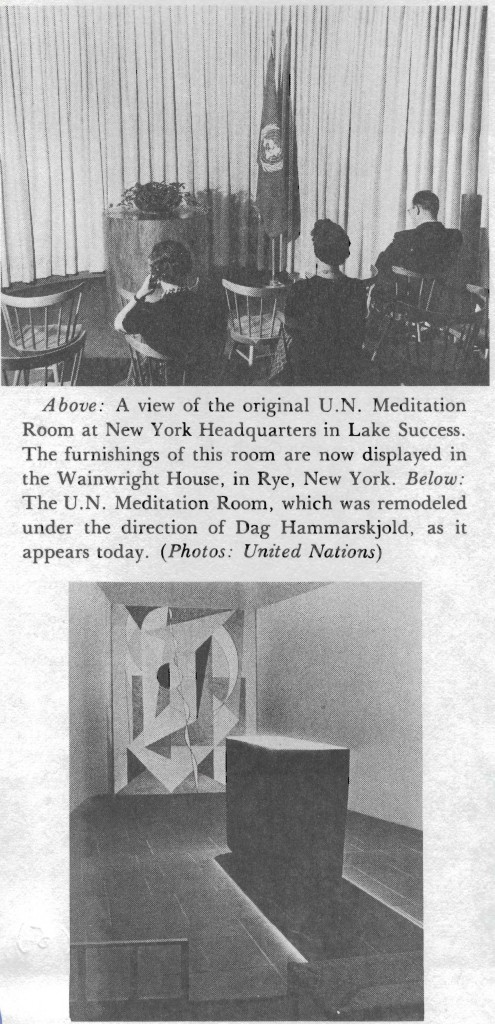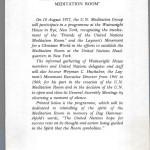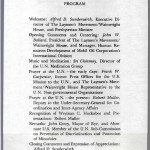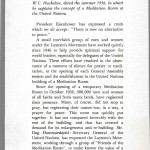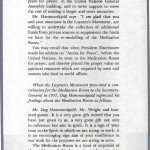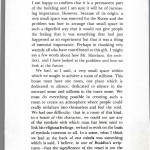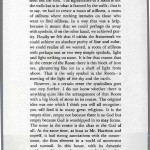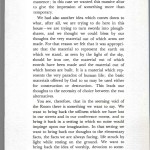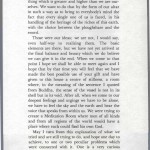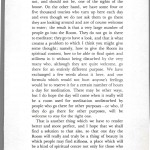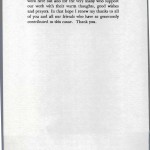Background on original “Friends of the Meditation Room” 27 Jul 1977
Filed under Room of QuietIn advance of a proposed meeting the meditation group members collected some back ground information to be shared in advance. The 27 July 1977 periodic bulletin “Meditation at the UN” included some of this material
The Meditation Group was invited to participate on 110 August 1977, in a programme at the Wainwright House in Rye, New York,. The event would recognise the involvement
of the “Friends of the UN Meditation Room” and the Laymen’s Movement in the efforts to establish the Meditation Room at UN Headquarters in New York
Excerpts of background information are presented below:
Here are links to pages and report of the 10 August meeting itself :
B. Excerpts on History of meditation Room – Wainwright House, Aug 10 1977
C. Extended remarks from 10 Aug 1977 – more history on UN Meditation Room
original meditation room
Gallery:
- bu-scpmaun-1977-07-27-vol-05-n-07-jul_Page_25.j
- bu-scpmaun-1977-07-27-vol-05-n-07-jul_Page_26
- bu-scpmaun-1977-07-27-vol-05-n-07-jul_Page_27
- bu-scpmaun-1977-07-27-vol-05-n-07-jul_Page_30.
- bu-scpmaun-1977-07-27-vol-05-n-07-jul_Page_31
- bu-scpmaun-1977-07-27-vol-05-n-07-jul_Page_34
Excerpted cut and paste from OCR scan of Jul 1977 Bulletin”Meditation at he UN”
Would need to be compared to images in gallery above, clean up/edit and run spell check:
“FRIENDS OF The UNITED NATIONS MEDITATION ROOM”
On 10 August 1977, the Meditation Group will
un’ll participate in a programme at the Wainwright
House in Rye, New York, recognising the involvement
of the “Friends of the United Nations
Meditation Room” and the Laymen’s Movement
for a Christian World in the efforts to establish the
Meditation Room at the United Nations Headquarters
in New York
The znformal gathenng of Wainwright House
members and Unüed Natzoons delegates and staff
un’ll also ho/tour Weyman Co Huckabee, the Laymen’s
Movement ExecutzOve Dzrector from 1941 to
1969, for his part zn the creatzOon of the u.N.
MedzOtatz”on Room and zn the decision of the u.N.
to open and close ÜS General Assembly Meetzngs by
observzng a moment of szolenceo
Prz°nted below is the programme, whzoch unU be
dedicated to rekzndlzng of the spzrü of the
MedüatzOon Room zn memory of Dag Hammarskjold’s
words, “The UnzOted NatzOons hope for
success rests on Üs thought and actzOon bezng guzOded
zn the SpzonOt that the Room symbolzZeso ”
23
PROGRAM
Program contents:
- Opening – Silent Meditation and Musical Selections by Sri Chinmoy
- Mr. John Ballard , President of the Laymen’s Movement and Wainwright House
- Mr. Francis W. Carpenter, Representative of the Laymen‘s Movement
- Dr. Robert Muller, Deputy Under-Secretary-General
- Dr. Alfred Sunderwirth, Executive Director of the Laymen‘s Movement and Wainwright House
- Mr. Weyman Huckabee
- Mr. Robert McEvoy, City Manager of Rye, NY:
- Note on Wainwright House by Alfred Sunderwirth:
Links to main programme and related photos are also at t
Closing Comments and Expression of Appreciation :
Alfred D. Sunderwirth
24
Following is an excerpt from a letter by Mr. W. C. Huckabee, dated the summer 1956, in which he explains the concept 01 a Meditation Room at the United Nations.
President Eisenhower has expressed a truth whieh we all accept: “There is now no alternative to peace.”
A small interfaith group of men and women
under the Layrnen’s Movement have worked quietly
sinee 1946 to help provide spiritual support for
world leaders, especially the delegates of the United
Nations. These efforts have resulted in the observanee
of a moment of silenee for prayer or meditation,
at the opening of eaeh General Assembly
session and the establishment in the United Nations
building of a Meditation Room.
Sinee the opening of a temporary Meditation
Room in Oetober 1952, 300,000 men and women
of all faiths and from many lands, have registered
their presenee. Many, of eourse, did not stop to
pray, but registering their names was, in a way, a
prayer for peaee. This room was quiekly put
together. It has not eompared favorably with the
rest of the building, and that has ereated a
demand for its enlargement and re-building. Mr.
Dag Harnmarskjold-Seeretary General of the
United Nations, has requested the Layrnen’s Movement,
working through a group of “Friends of the
Meditation Room”, to make known the value of a
25
place for prayer, in the United Nations’ General
Assembly building. and to invite support to cover
the cost of making it larger and more attractive.
Mr. Harnmarskjold says: “1 am glad that you
and your associates in the Layrnen’s Movement, are
willing to undertake the collection of additional
funds from private sources to supplement the funds
we have for the re-modelling of the Meditation
Room.”
y ou may recall that when President Eisenhower
made his address on “Atoms for Peace”, before the
United Nations, he went to the Meditation Room
for prayer, and thereby placed the proper value on
spiritual resources which are required by men and
women who lead in world affairs.
When the Laymen s Movement prest nted a contribution
for the Meditation Room to the SecretaryGeneral
in 1957, Dag Hammarskjold expressed his
feelz”ngs about the Meditation Room as follows.
Mr. Dag Hammarskjold: Mr. Wright and hon·
ored guests: It is a very great gift indeed that you
have just given to us, a very great gift not only
in substance but also in spirit. It is a sign of your
trust in the Spirit in which we are trying to work; it
is an encouraging sign also of your confidence in
our work for the purposes we are trying to serve.
The Meditation Room is a kind of stepchild of
the architects of this house; it was brought into
26
being, as you have said, as an experiment, but now
I am happy to confirm that it is a permanent part
of the building and I am sure it will be of increasing
importance. However, because of its origin, a
very small space was reserved for the Room and the
problem was how to arrange that small space in
such a dignified way that it would not give people
the feeling that it was something that had just
happened as an experiment but that it was a thing
of essential importance. Perhaps in thanking very
warmly all who have contributed to this gift, I might
saya few words about how Mr. Harrison, the architect,
and I have looked at the problem and how we
look at the future.
We had, as I said, a very small space within
which we sought to achieve a room of stillness. 11ús
house must have one room, one place which is
dedicated to silence, dedicated to silence in the
outward sense and stillness in the inner sense. We
must do everything possible in creating such a
room to create an atmosphere where people could
really withdraw into themselves and feel the void.
We had one difficulty: that in a room of this kind,
in a house of this character, we could not use any
of the symbols with which man has been used to
link his religious feelings; we had to work on the basis
of symbols cornmon to all. In a sense, what I think
we had at the back of OUT minds was something
which is said, I believe, in one of Buddha’s scriptures
– that the significance of the vessel is not the
27
shell but the void. The significance of a room is not
the waHs but is in what is framed by the walls; that is
to say, we had to create a room of stillness, a room
of stillness where nothing intrudes on those who
want to find stillness. In a way that was a help ,
because it meant that we could perhaps do away
with symbols, if on the other hand, we achieved purity.
FinaHy we felt that if within the framework we
could achieve an absolute purity of line and color,
we could realize aH we wanted, a room of stillness
with perhaps one or two very simple symbols, light
and light striking on stone. It is for that reason that
in the centre of the Room there is this block of iron
ore, glimmering like ice in a shaft of light from
above. That is the only symbol in the Room-a
meeting of the light of the sky and the earth.
However, in a certain sense the symbolism goes
one step further. I do not know whether there is
anything quite like the arrangement of that Room
with a big block of stone in its centre. The original
idea was one which I think you wiH aH recognize;
you wiH find it in many great religions. It is the
empty altar, empty not because there is no God but
empty because God is worshipped in so may forms.
The stone in the centre is the altar to the God of
all. At the same time, at least to Mr. Hamson and
myself, it had strong associations with the comerstone,
the firm element in a world of movement
and turmoil. In this house, with its dynamic
modem architecture, there are very few things that
28
give you the feeling of weight, solidity and permanence;
in this case we wanted this massive altar
to give the impression of something more than
temporary.
We had also another idea which comes down to
what, after all, we are trying to do here in this
house-we are trying to turn swords into ploughshares,
and we thought we could bless by our
thoughts the very material out of which arms are
made. For that reason we felt that it was appropriate
that the material to represent the earth on
which we stand, as seen by the light of the sky,
should be iron ore, the material out of which
swords have been made and the material out of
which homes are built. It is a material which represents
the very paradox of human life; the basic
materials offered by God to us may be used either
for construction or destruction. This leads our
thoughts to the necessity of choice between the two
alternatives .
You see, therefore, that in the seeming void of
the Room there is something we want to sayo We
want to bring back the stillness which we have lost
in our streets and in our conference rooms, and to
bring it back in a setting in which no noise would
impinge upon our imagination. In that setting we
want to bring back our thoughts to the elementary
facts, the facts we are always facing, life struck by
light while resting on the ground. We want to
bring back the idea of worship, devotion to some-
29
thing which is greater and higher than we are ourselves.
We want to do that by the form of our altar
in such a way as to bring to everybody’s mind the
fact that every single one of us is faced, in his
handling of the heritage of the riches of this earth,
with the choice between the ploughshare and the
sword.
Those were our ideas; we are not, 1 would say,
even half-way to realizing them. The basic
elements are there, but we have not yet arrived at
the final balance and beauty which we do believe
we can give it in the end. When we come to that
point 1 hope we shaIl be able to meet again and 1
hope that by that time you wiIl feel that we have
made the best possible use of your gift and have
given to this house a centre of stillness, a room
where, in the meaning of the sentence 1 quoted
from Buddha, the sense of the vessel is not in its
sheIl but in its void. Mter aIl, when we come to our
deepest feelings and urgings we have to be alone,
we have to feel the sky and the earth and hear the
voice that speaks from within uso We were trying to
create a Meditation Room where men of aIl kinds
and from aIl regions of the world would have a
place where each could find his own God.
May 1 turn from this explanation of what we
tried and are still trying to do, and hope one day to
achieve, to one or two peculiar problems which
were connected with it. One is a very curious
problem indeed. The Meditation Room is not on
30
the route of the guided tours of the building; it is
not, and should not be, one of the sights of the
house. On the other hand, we have sorne four or
five thousand tourists who turn up here each day
and even though we do not ask them to go there
they are looking around and are of course welcome
to enter; the result is that a very large number of
people go into the Room. They do not go in there
to meditate; they go to have a look, and that is what
creates a problem to which 1 think you might give
sorne thought; namely, how to give the Room its
spiritual content, how to be able to find quiet and
stillness in it without being disturbed by the very
many who, although they are quite welcome, go
there for an entirely different purpose. We have
exchanged a few words about it here, and one
formula which would not hurt anyone’s feelings
would be to reserve it for a certain number of hours
a day for meditation. There may be other ways,
but 1 do hope the day wiIl come when it reaIly wiIl
be a room used for meditation undisturbed by
people who go there for other purposes-or who, if
they do go there for other purposes, wiIl be
welcome to stay for the right one.
That is another thing which we have to render
better and more perfect, and 1 hope that we shaIl
find a solution to that also, so that one day the
Room wiIl really and truly be a thing of beauty in
which people may find stillness, a place which wiIl
be a kind of spiritual centre not only for those who
31
work here but also for the very many who support
our work with their warm thoughts. good wishes
and prayers. In that hope I renew my thanks to all
of you and all our friends who have so generously
contributed to this cause. T’hank you.
32
